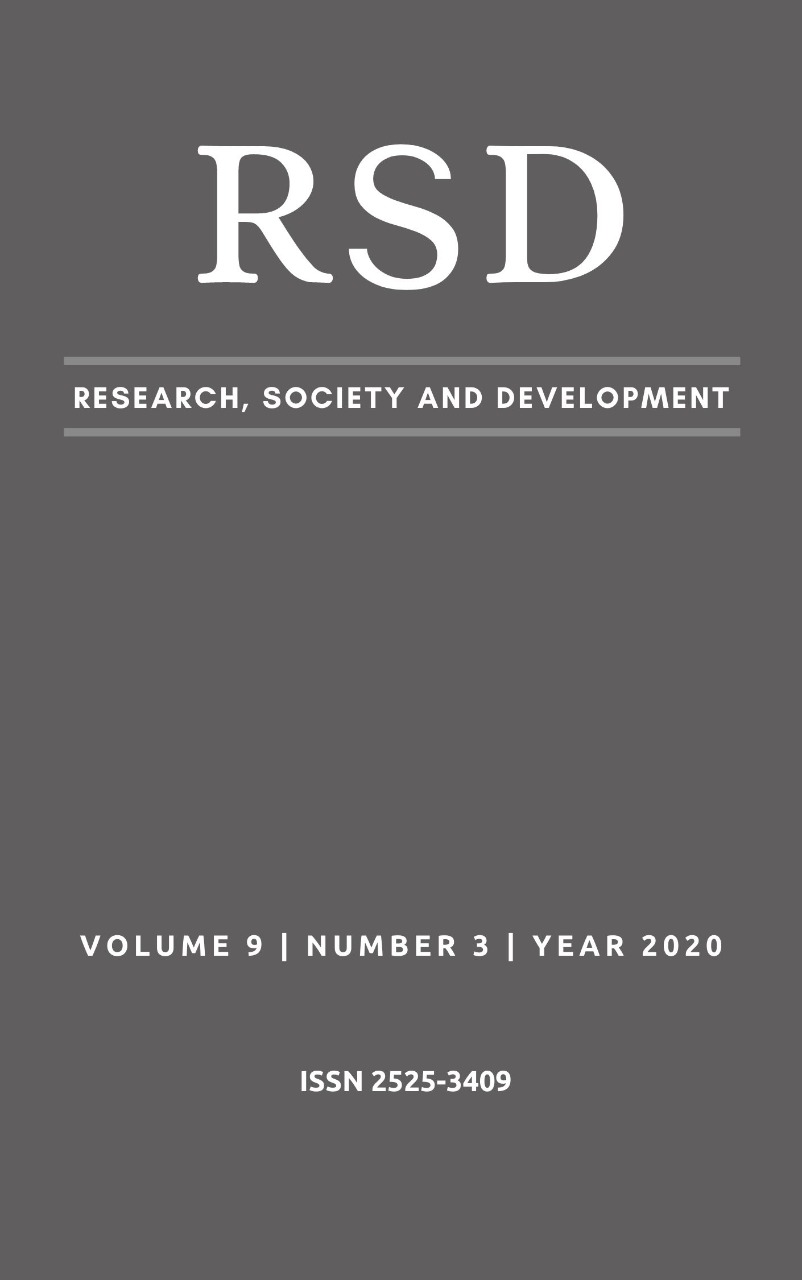Avaliação da resistência à corrosão em chapas de aço-carbono protegidas por revestimentos nanocerâmicos a base de zircônio e titânio
DOI:
https://doi.org/10.33448/rsd-v9i3.2715Palavras-chave:
Zircônio, Titânio, Revestimentos, Nanocerâmicos.Resumo
O pré-tratamento de superfícies metálicas é um processo conhecido e utilizado com o intuito de aumentar o desempenho contra a corrosão, bem como melhorar a aderência entre o substrato e a camada de tinta. O presente trabalho avaliou a resistência a corrosão do aço carbono antes e após o tratamento com revestimentos nanocerâmicos. A comparação foi entre um composto nanocerâmico de zircônia (Bonderite NT-1) puro, este com a adição de um dispersante (ácido poliacrílico) e um outro revestimento nanocerâmico desenvolvido a partir do óxido de titânio. Adicionalmente, foram realizados testes de névoa salina, potencial de circuito aberto (OCP), polarização e impedância para obter uma metodologia para avaliar quantitativamente a qualidade da proteção. O revestimento de zircônia apresentou melhor proteção a corrosão em relação ao revestimento de titânio e aço carbono sem revestimento. O potencial de corrosão deste revestimento foi cerca de duas vezes menor que o aço carbono sem revestimento, enquanto para o revestimento de titânio foi cerca de 1,5 vezes menor. A adição de dispersante não produziu melhorias significativas na resistência a corrosão e se mostrou semelhante ao aço carbono sem revestimento, possivelmente pela alta concentração utilizada.
Referências
Adhikari, S., Unocic, K. A., Zhai, Y., Frankel, G. S., Zimmerman, J., & Fristad, W. (2011). Hexafluorozirconic acid based surface pretreatments: Characterization and performance assessment. Electrochimica Acta, 56(4), 1912–1924. Retrieved from https://doi.org/10.1016/j.electacta.2010.07.037
Behzadnasab, M., Mirabedini, S. M., & Esfandeh, M. (2013). Corrosion protection of steel by epoxy nanocomposite coatings containing various combinations of clay and nanoparticulate zirconia. Corrosion Science, 75, 134–141. Retrieved from https://doi.org/10.1016/j.corsci.2013.05.024
Bossardi, K. (2007). Nanotecnologia aplicada a tratamentos superficiais para o aço carbono 1020 como alternativa ao fosfato de zinco (Dissertação (Mestrado em Engenharia de Minas, Metalurgia e Materiais), Universidade Federal do Rio Grande do Sul). Retrieved from https://doi.org/10.23943/9781400889877
Costa, J. S., Agnoli, R. D., & Ferreira, J. Z. (2015). CORROSION BEHAVIOR OF A CONVERSION COATING BASED ON ZIRCONIUM AND COLORANTS ON GALVANIZED STEEL BY ELECTRODEPOSITION. Tecnologia Em Metalurgia Materiais e Mineração, 12(2), 167–175. Retrieved from https://doi.org/10.4322/2176-1523.0852
Droniou, P., & Fristad, W. E. (2005). Nanoceramic-based Conversion Coating: Ecological and economic benefits position process as a viable alternative to phosphating systems. Organic Finishing, 103, 41–43. Retrieved from https://doi.org/10.1016/S0026-0576(05)80849-9
Gentil, V. (2011). Corrosão (6th ed.). Rio de Janeiro: LTC.
Guo, L., Kaya, S., Obot, I. B., Zheng, X., & Qiang, Y. (2017). Toward understanding the anticorrosive mechanism of some thiourea derivatives for carbon steel corrosion: A combined DFT and molecular dynamics investigation. Journal of Colloid and Interface Science, 506, 478–485. Retrieved from https://doi.org/10.1016/j.jcis.2017.07.082
Hadinata, S. S., Lee, M. T., Pan, S. J., Tsai, W. T., Tai, C. Y., & Shih, C. F. (2013). Electrochemical performances of diamond-like carbon coatings on carbon steel, stainless steel, and brass. Thin Solid Films, 529, 412–416. Retrieved from https://doi.org/10.1016/j.tsf.2012.05.041
Milošev, I., & Frankel, G. S. (2018). Review—Conversion Coatings Based on Zirconium and/or Titanium. Journal of The Electrochemical Society, 165(3), C127–C144. Retrieved from https://doi.org/10.1149/2.0371803jes
Popić, J. P., Jegdić, B. V., Bajat, J. B., Veljović, D., Stevanović, S. I., & Mišković-Stanković, V. B. (2011). The effect of deposition temperature on the surface coverage and morphology of iron-phosphate coatings on low carbon steel. Applied Surface Science, 257(24), 10855–10862. Retrieved from https://doi.org/10.1016/j.apsusc.2011.07.122
Rahman, S. U. (2011). Corrosion protection of steel by catalyzed polypyrrole films. Surface and Coatings Technology, 205(8–9), 3035–3042. Retrieved from https://doi.org/10.1016/j.surfcoat.2010.11.018
Ramanathan, E., & Balasubramanian, S. (2016). Synthesis and characterization of hexafluorozirconic acid powder and its application in nanoceramic coating. Surface and Coatings Technology, 304, 228–236. Retrieved from https://doi.org/10.1016/j.surfcoat.2016.07.009
Ramanauskas, R., Girčienė, O., Gudavičiu¯tė, L., & Selskis, A. (2015). The interaction of phosphate coatings on a carbon steel surface with a sodium nitrite and silicate solution. Applied Surface Science, 327, 131–139. Retrieved from https://doi.org/10.1016/j.apsusc.2014.11.120
Roman, D., Bernardi, J., Amorim, C. L. G. de, Figueroa, C. A., Baumvol, I. J. R., & Basso, R. L. de O. (2011). SÍNTESE E CARACTERIZAÇÃO DE FILMES FINOS DE ZrN DEPOSITADOS EM DIFERENTES TEMPERATURAS. Tecnologia Em Metalurgia e Materiais, 8(3), 174–178. Retrieved from https://doi.org/10.4322/tmm.2011.027
Sugiarti, E., Destyorini, F., Zaini, K. A., Wang, Y., Hashimoto, N., Ohnuki, S., & Hayashi, S. (2015). Characterization of Ni-based coatings on carbon steel by electron microscopy. Surface and Coatings Technology, 265, 68–77. Retrieved from https://doi.org/10.1016/j.surfcoat.2015.01.061
Wolynec, S. (2003). Técnicas Eletroquímicas em Corrosão. São Paulo: Ed. Edusp.
Zhang, L., Duan, Y., Gao, R., Yang, J., Wei, K., Tang, D., & Fu, T. (2019). The Effect of Potential on Surface Characteristic and Corrosion Resistance of Anodic Oxide Film Formed on Commercial Pure Titanium at the Potentiodynamic-Aging Mode. Materials, 12(3), 370. Retrieved from https://doi.org/10.3390/ma12030370
Downloads
Publicado
Edição
Seção
Licença
Autores que publicam nesta revista concordam com os seguintes termos:
1) Autores mantém os direitos autorais e concedem à revista o direito de primeira publicação, com o trabalho simultaneamente licenciado sob a Licença Creative Commons Attribution que permite o compartilhamento do trabalho com reconhecimento da autoria e publicação inicial nesta revista.
2) Autores têm autorização para assumir contratos adicionais separadamente, para distribuição não-exclusiva da versão do trabalho publicada nesta revista (ex.: publicar em repositório institucional ou como capítulo de livro), com reconhecimento de autoria e publicação inicial nesta revista.
3) Autores têm permissão e são estimulados a publicar e distribuir seu trabalho online (ex.: em repositórios institucionais ou na sua página pessoal) a qualquer ponto antes ou durante o processo editorial, já que isso pode gerar alterações produtivas, bem como aumentar o impacto e a citação do trabalho publicado.


